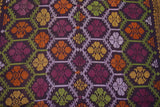Old Superb Ceremonial Balinese hand woven textile antique Multi-color Embroidered Songket Brocade Damask Bride Price Heirloom Textile Art 60" x 39" (SG5) Collected in Negara, Bali, Indonesia.
TEXTILES OF THE PAST
Museum Piece, Old Brocade Songket Cloth Collectible, Purchased from the Court of Negara. Once Belonged to Balinese Royalty / Nobility. Multi-colored Traditional Embroidery Handwoven with Handspun Silk and Cotton Blend
SIZE: 60" x 39"
ITEM: SG5
Collected in Negara, Bali, Indonesia.
Handspun Handwoven silk blend with colorful threads' embroideries done by hand. In great shape for its age, we were told it was 100 yrs old by the owner. The textile consists of 2 panels once each woven in a regular loom and passed on as heirlooms from mother to daughter and so on, and much later they were sewn together as a sarong to be used in court ceremonies. The textile is in great shape for its agebut I noticed, with difficulty, 8 pin holes when I looked in front of the light as they are not easily noticeable otherwise.
We have sold these pieces in the $1,000.00's and up in the past. We are looking to liquidate what is left.
Songket is a fabric that belongs to the family of brocade textiles. It is hand woven in silk or cotton, and intricately patterned with gold or silver threads. The metallic threads stand out against the background cloth to create a shimmering effect. In the weaving process the metallic threads are inserted in between the silk or cotton weft (latitudinal) threads. The term songket comes from the Malay Indonesian word sungkit, which means "to hook". It has something to do with the method of songket making; to hook and pick a group of threads, and then slip the gold threads in it. The word menyongket means "to embroider with gold or silver threads".
Songket is a luxury product traditionally worn during ceremonial occasions as sarong, shoulder cloths or head ties. Tanjak or Songket headdresses were worn at the courts of the Malay Sultanates and nobility. Traditionally women and adolescent girls wove songket and traditionally-patterned textiles embodied a system of interpretable emblems to the few that were able to create them and wear them.
Few costumes in the world have the dignified elegance of the ceremonial costume of a noblewoman: the underskirt dragging on the ground in a train of silk and gold; the torso, bound from the hips to the armpits; first is a strong bulang, a strip of cloth covered by a sabuk, another strip of silk overlaid, and gold leaf and gold plugs through her ears.
All our collector and rare items come with pages and pages of research about provenance, and with history of the tribes and photos as well, depending on item and whenever possible. If you have any questions or want to see research conducted on this piece and photos of tribes, tell us.























